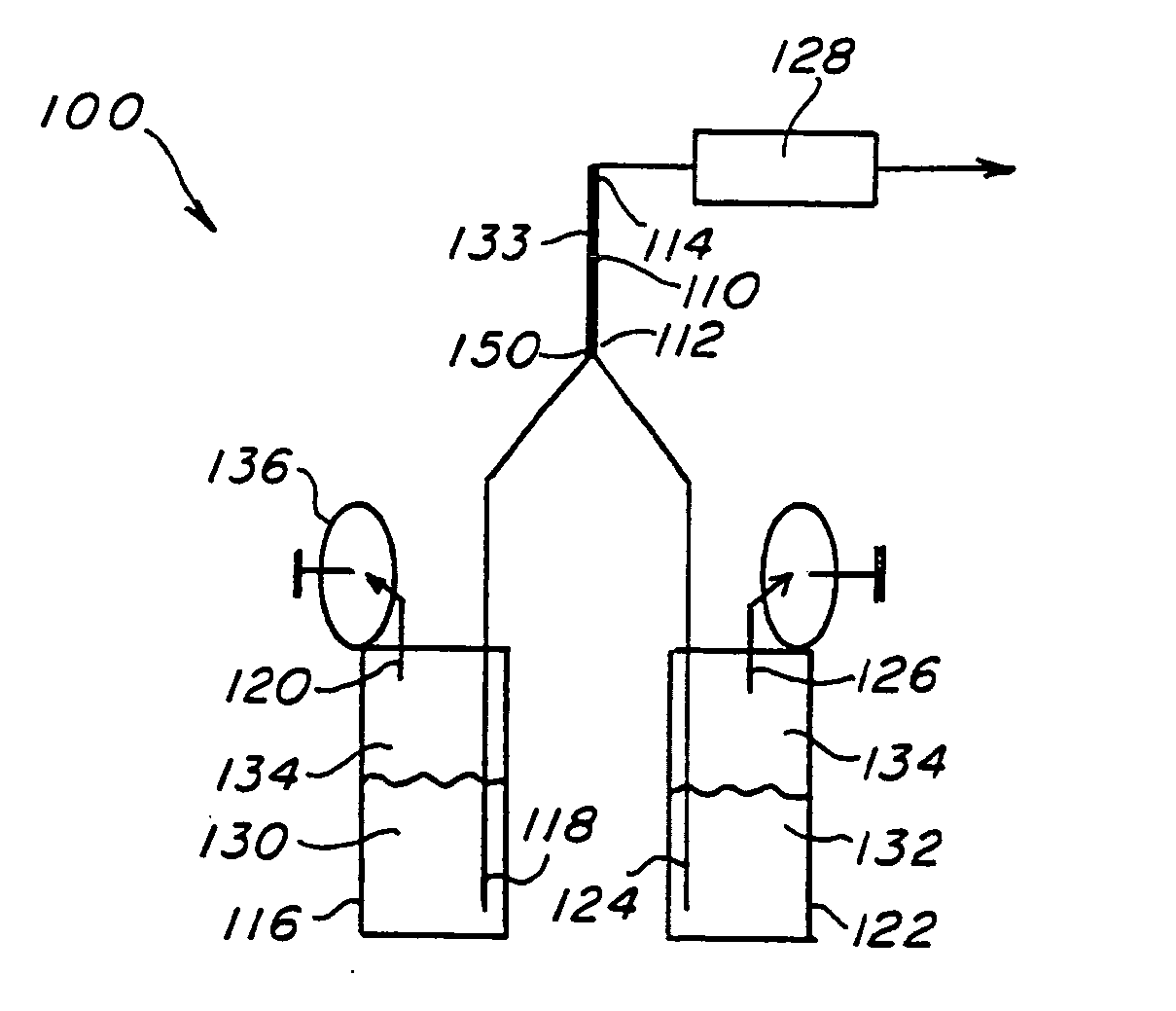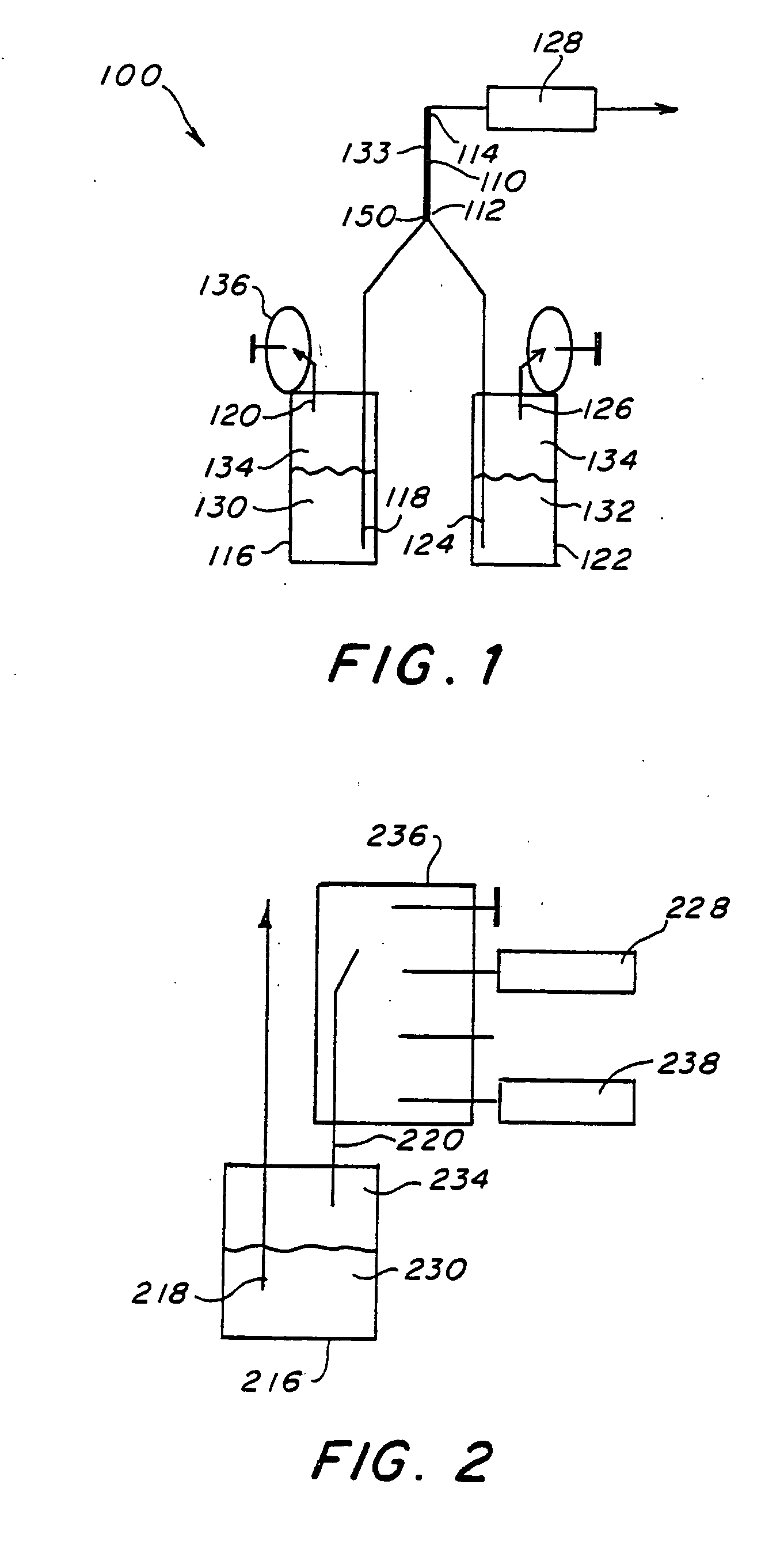Fluidics system
a fluidics and system technology, applied in the field of fluidics systems, can solve the problems of clogging of complex sample matrices by components of complex sample matrices, unsatisfactory demand for fluidics systems, and impracticality of portable analysis systems,
- Summary
- Abstract
- Description
- Claims
- Application Information
AI Technical Summary
Benefits of technology
Problems solved by technology
Method used
Image
Examples
example i
[0085] A schematic illustration of an exemplary fluid flow control arrangement 400 is depicted in FIG. 4. Arrangement 400 includes three reservoirs 416, 422, and 460 in which respective fluids 430, 432, 462 and gas space 434 are contained. The reservoirs are all fluid-tight (enclosed). Fluidly connected to each reservoir is a respective pressure relief valve 464, 466, 468. Pressure relief valves can be manually or remotely actuated to move between an open position where pressure relief or air is provided to the respective reservoir and a closed position where no pressure relief or air is provided to the respective reservoir. In this arrangement, pressure relief valves are each automatically actuated remotely by a suitable control 470 as schematically shown, and are in a closed (default) position when not actuated. Extending into or near a bottom of each respective reservoir is a respective outlet pathway or duct 418, 424, 472. The outlet ducts are connected by a manifold, 450, to a ...
example ii
[0088] Depicted schematically in FIG. 5 is a first embodiment of a portable bio / chemical analysis system 500 incorporating a fluid flow control arrangement as broadly discussed above whereby a plurality of sample fluids can be first simultaneously analyzed and then can be further simultaneously analyzed after addition of one or more reagents. The system includes a bio / chemical analysis device 574 having analyzing channels 576 in which analysis of a fluid can be performed as is well known in the art. One surface of the analyzing channels 576 can be a waveguide for performing optical analysis. For example, a waveguide in the plane of the figure co-extensive in area with the analysis device 574 could be used. Each analyzing channel 576 includes an associated inlet 578 and an associated outlet 580 as shown. Associated with each analyzing channel 576 is a sample reservoir / chamber 516 in which a sample fluid 530 and air 534 are respectively provided.
[0089] First pathways or ducts 518 res...
example iii
[0100] As shown schematically in FIG. 1, two reservoirs 116, 122 were connected through a manifold 150 to a primary fluid channel 110 comprising fluorescence detector, 133. The fluorescence detector was used to detect a fluorescent dye in one of the fluids 130, possibly water. The reservoir 116 contained water. Reservoir 122 contained a 60 nM aqueous solution of fluorescent dye Cy5, 132. Each reservoirwas sealed, closed, to the atmosphere except that each was connected to vents 120, 126 to micro relief valves 136 (“vent 1”) and (“vent 2”) (LFAA12034, The Lee Company), respectively. The default closed position of the valve caused the given reservoir to be sealed from the atmosphere. The relief valves 136 could be individually actuated (via a 12 volt signal) to open a given reservoir to atmospheric pressure. The negative pressure source 128 was a peristaltic pump, running at 1.5 ml / min. It was used to draw fluid from each of the reservoirs and through the fluid channel 110 comprising ...
PUM
 Login to View More
Login to View More Abstract
Description
Claims
Application Information
 Login to View More
Login to View More - R&D
- Intellectual Property
- Life Sciences
- Materials
- Tech Scout
- Unparalleled Data Quality
- Higher Quality Content
- 60% Fewer Hallucinations
Browse by: Latest US Patents, China's latest patents, Technical Efficacy Thesaurus, Application Domain, Technology Topic, Popular Technical Reports.
© 2025 PatSnap. All rights reserved.Legal|Privacy policy|Modern Slavery Act Transparency Statement|Sitemap|About US| Contact US: help@patsnap.com



